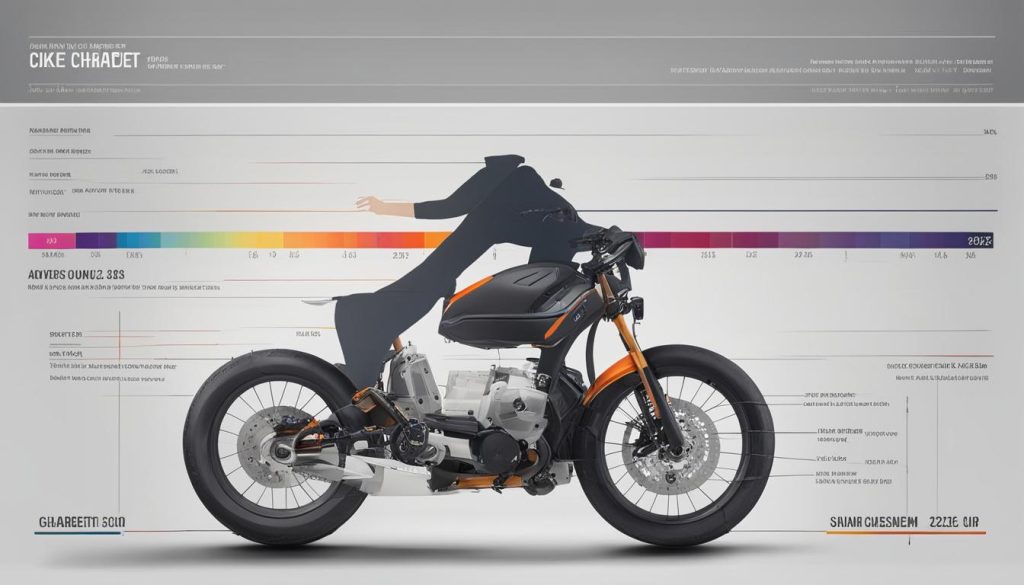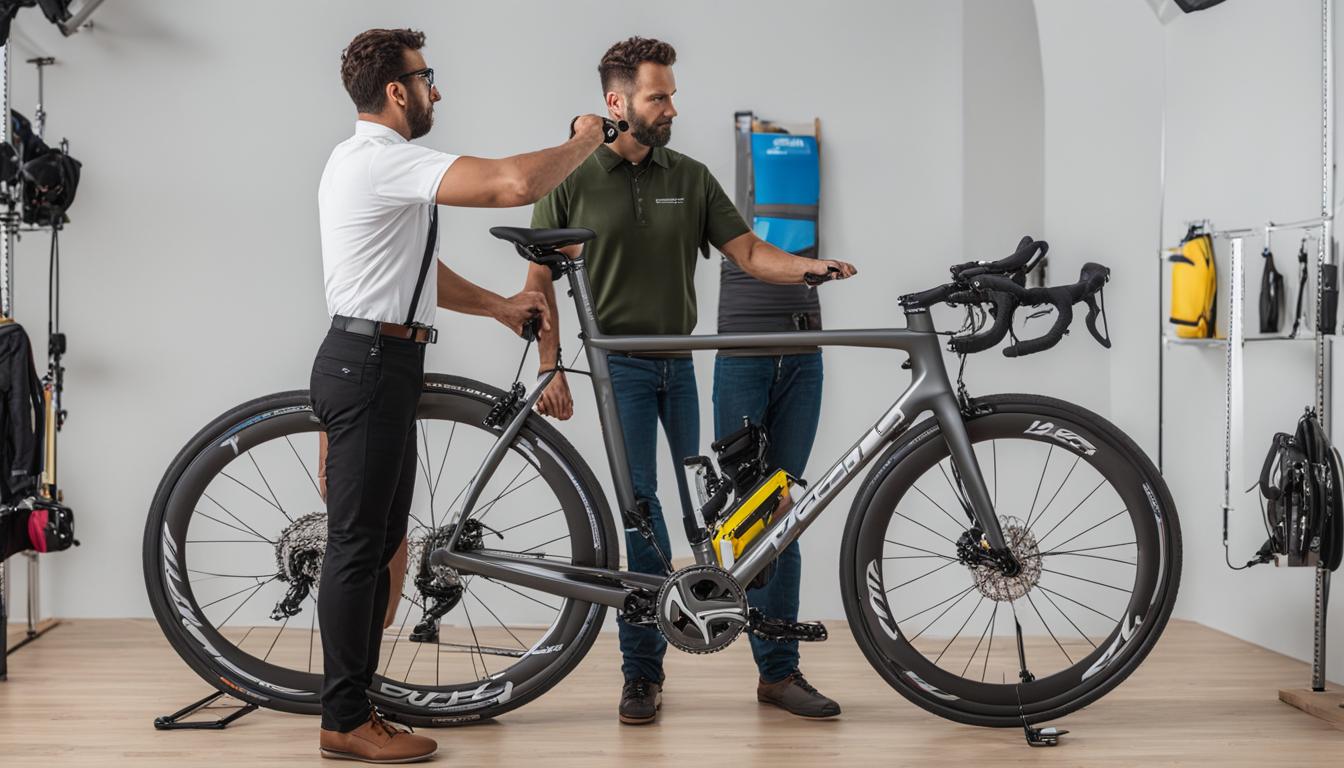Determining the right bike size is crucial for comfort and safety while cycling. Whether you’re a seasoned cyclist or a beginner, these tips will help you find the perfect fit. Start by understanding your riding style, such as commuting, leisurely rides, or racing, as different styles require different bike sizes. Consider the various bike types available, including road bikes, mountain bikes, city bikes, and hybrids.
Read More : Master the Art: How to Draw a Bike Step-by-Step Guide
To measure your inseam, stand with your back against a wall and use a book to measure the distance from the floor to the top of the book. Consult a bike size chart to determine the appropriate frame size based on your height and age. Use a bike size calculator to calculate your frame size accurately. Additionally, flexibility and seat post and stem length should be taken into account when selecting the right bike size. Finally, test ride the bike to ensure it feels comfortable and balanced.
Key Takeaways:
- Understanding your riding style is essential in determining the right bike size.
- Consider the different bike types available, such as road bikes, mountain bikes, city bikes, and hybrids.
- Measure your inseam to determine your frame size accurately.
- Consult a bike size chart or use a bike size calculator to find the appropriate bike size.
- Take into account flexibility, seat post length, and stem length for a proper bike fit.
Determining Your Riding Style and Choosing the Right Bike Type
Determining your riding style is an essential step in finding the perfect bike size for you. By understanding how you plan to use your bike, you can choose a type that suits your needs and preferences. Here’s a guide to help you determine your riding style and select the right bike type:
Determine Your Riding Style
Consider how you’ll be using your bike. Are you planning to commute to work or school? Do you want to enjoy leisurely rides on weekends? Are you interested in racing or engaging in high-intensity workouts? Different riding styles require different bike sizes and fits. Take some time to reflect on your goals and preferences before making a decision.
Choose the Right Bike Type
Once you’ve determined your riding style, it’s time to choose the right bike type. Here are some popular options:
- Road Bikes: Ideal for speed and efficiency on paved roads. They are lightweight and designed for long-distance rides.
- Mountain Bikes: Perfect for off-road terrains, such as trails and mountains. They have sturdy frames, powerful brakes, and suspension features.
- City Bikes: Designed for urban environments, these bikes are comfortable and practical for commuting and leisurely rides around town.
- Hybrid Bikes: Offer a versatile riding experience, combining features from both road and mountain bikes. They are great for recreational rides and light trails.
Consider your riding goals, the terrain you’ll be riding on, and your personal preferences when selecting the right bike type. Each type has its unique characteristics and advantages, so take your time to choose the one that suits you best.

Now that you have a better understanding of your riding style and the different bike types available, you’re one step closer to finding the perfect fit. In the next section, we’ll explore how to measure your inseam and use size charts to determine the appropriate bike size for your body.
Section 3: Measuring Inseam and Using Size Charts
When it comes to finding the right bike size, measuring your inseam is crucial. Your inseam length will help determine the appropriate bike size that will provide the most comfortable and efficient riding experience. To measure your inseam, stand with your back against a wall and place a book between your legs, as if you were sitting on a bike seat. Measure the distance from the floor to the top of the book, and that will be your inseam length.
Once you have your inseam measurement, it’s essential to consult a bike size chart to determine the appropriate bike size for your height and body proportions. Different types of bikes may have different size charts, so ensure you are referring to the correct one. For road bikes, there is a specific road bike size chart available based on height. Mountain bikes also have their own size chart, and kids’ bikes have size charts based on height and age. It’s essential to note that these size charts are general guidelines and may vary slightly between brands.
Example: Road Bike Size Chart
| Height (inches) | Frame Size (inches) |
|---|---|
| 4’10” – 5’1″ | 47 – 49 |
| 5’1″ – 5’3″ | 50 – 52 |
| 5’3″ – 5’5″ | 53 – 55 |
| 5’5″ – 5’7″ | 56 – 58 |
| 5’7″ – 5’9″ | 58 – 60 |
While using the size chart is a helpful starting point, it’s always recommended to consult with a bike expert to ensure the best possible fit for your body and riding style. They can provide expert advice based on your measurements and help you choose the right bike size. Additionally, it’s crucial to test ride the bike to ensure it feels comfortable and suits your needs before making a final decision.
Summary
- Measuring your inseam is essential for determining the right bike size.
- Consult a bike size chart specific to the type of bike you are interested in.
- Remember that size charts are general guidelines and may vary between brands.
- Seek the advice of a bike expert to ensure the best fit for your body and riding style.
- Test ride the bike to ensure it feels comfortable and suits your needs.

Tips for Proper Bike Fitting and Final Considerations
As you strive to find the perfect bike size, it’s important to consider your flexibility. Your body’s range of motion can greatly impact your comfort on the bike and your ability to ride efficiently. If you have limited flexibility, look for a bike with a shorter top tube or higher handlebars. This will help you maintain an upright position and prevent strain on your lower back and neck.
Don’t overlook the importance of seat post and stem length. These components play a significant role in your riding position and overall comfort. Seek expert advice to determine the best seat post and stem length for your body and riding style. Bike experts have the knowledge and experience to guide you in making the right choices that can enhance your riding experience.
When it comes to finding the right bike size, consulting with a knowledgeable bike expert is invaluable. They can analyze your measurements, riding style, and preferences to recommend the best bike size for you. Their expertise will ensure that you’re on the right track to finding the perfect fit.
Finally, don’t forget to test ride the bike before making a final decision. While all the measurements and recommendations are helpful, it’s essential to gauge how the bike feels for yourself. Take it out for a spin and pay attention to how it handles, whether it feels comfortable, and if it meets your specific needs. Only by test riding can you truly determine if the bike is the right match for you.
FAQ
How do I measure my bike size?
To measure your bike size, start by measuring your inseam. Stand against a wall and place a book between your legs, as if you were sitting on a bike seat. Measure the distance from the floor to the top of the book. Use this measurement to consult a bike size chart or calculator to determine the appropriate frame size based on your height and age.
How do I determine my riding style?
Your riding style depends on how you plan to use the bike. Consider if you’ll be commuting, going on leisurely rides, racing, or doing high-intensity workouts. Different riding styles require different bike sizes and fits. For commuting or leisurely rides, a more relaxed fit with a slightly larger bike size may be more comfortable. If you plan to race or do high-intensity workouts, a more aggressive fit with a slightly smaller bike size may be better suited for your needs.
How do I choose the right bike type?
Choose a bike type based on your riding goals and preferences. Road bikes are designed for speed and efficiency on paved roads, mountain bikes are designed for off-road terrains, city bikes are ideal for urban environments, and hybrids offer a versatile riding experience. Consider where you’ll be riding and the terrain you’ll encounter when selecting the proper bike type for you.
How do I use a bike size chart?
Use a bike size chart specific to the type of bike you’re interested in. These charts are based on height and, in some cases, age. Consult the manufacturer’s size chart and match your height to the corresponding frame size. Keep in mind that these size charts are general guidelines and may vary between brands. To ensure the best fit, it’s always best to consult with a bike expert or test ride different sizes.
What should I consider for proper bike fitting?
When selecting the right bike size, consider your flexibility. If you have limited flexibility, you may need a bike with a shorter top tube or higher handlebars to help maintain an upright position and prevent strain on your lower back and neck. Pay attention to the seat post and stem length as these components can significantly affect your riding position and comfort. Seeking expert advice can also be beneficial in determining the best bike size and fit for your body and riding style.
How important is a test ride?
Test riding a bike is crucial to ensure it feels comfortable and suits your needs. It allows you to experience the bike’s fit, handling, and comfort firsthand. Take the bike for a short ride and pay attention to how it feels when you’re cycling. If you have any doubts or discomfort, try a different size or style until you find the perfect fit.

